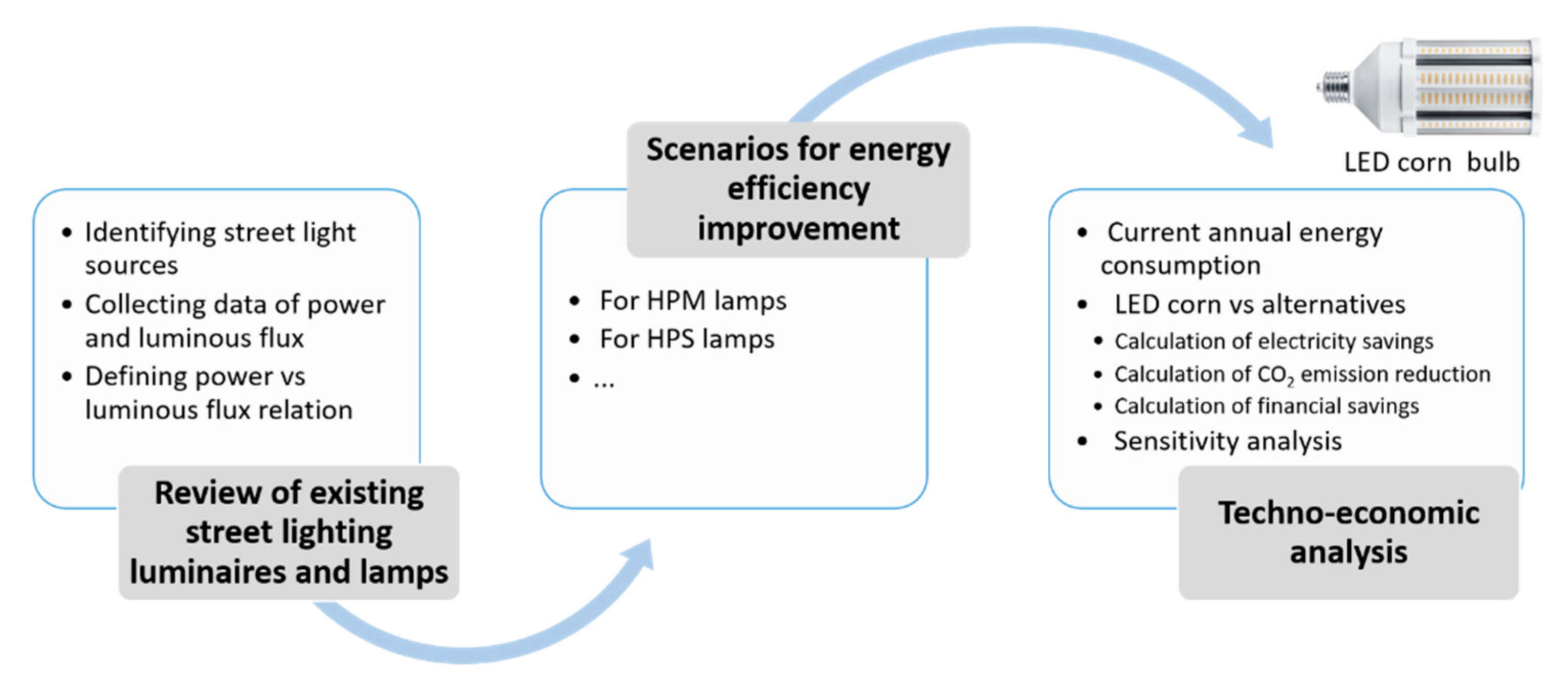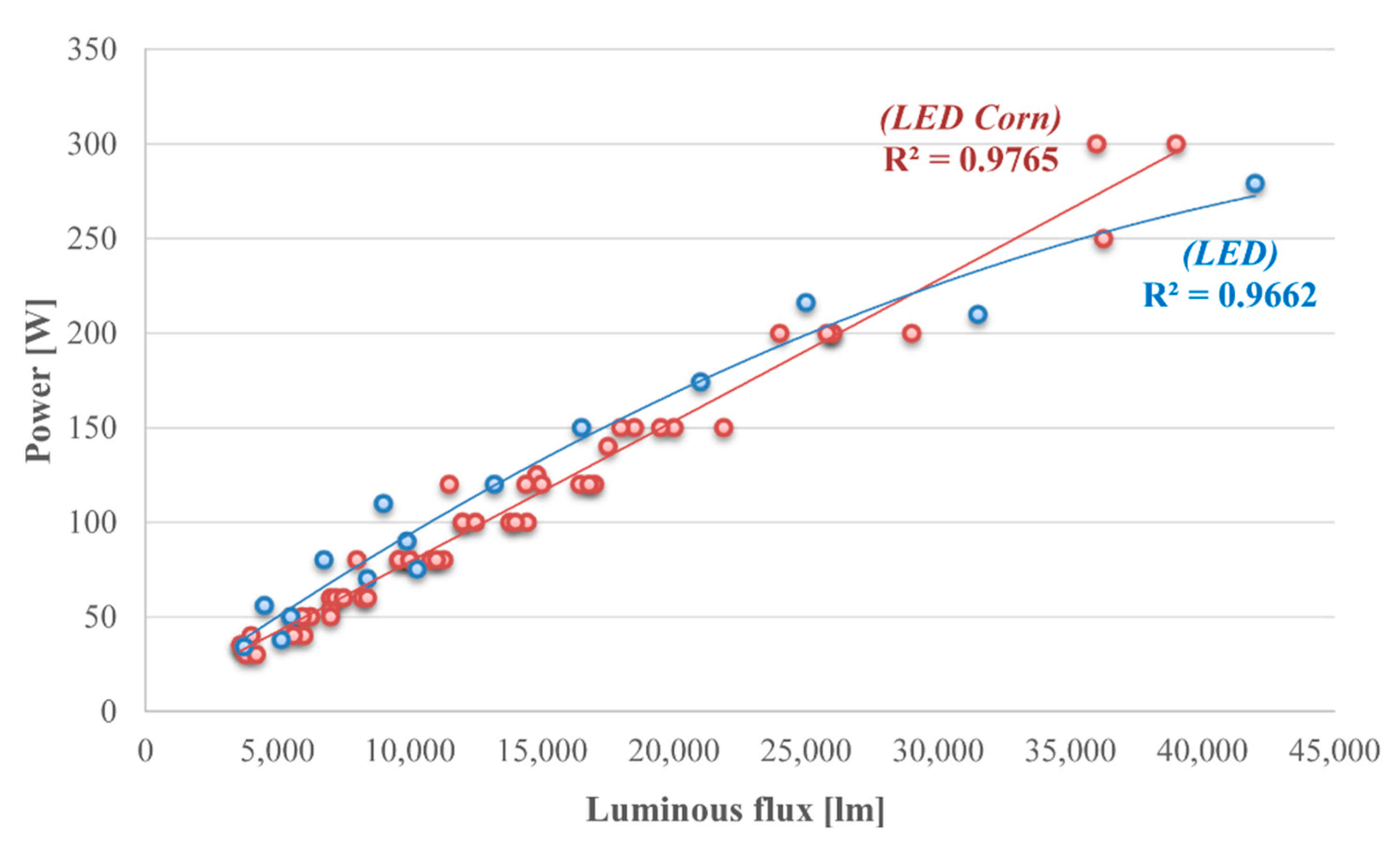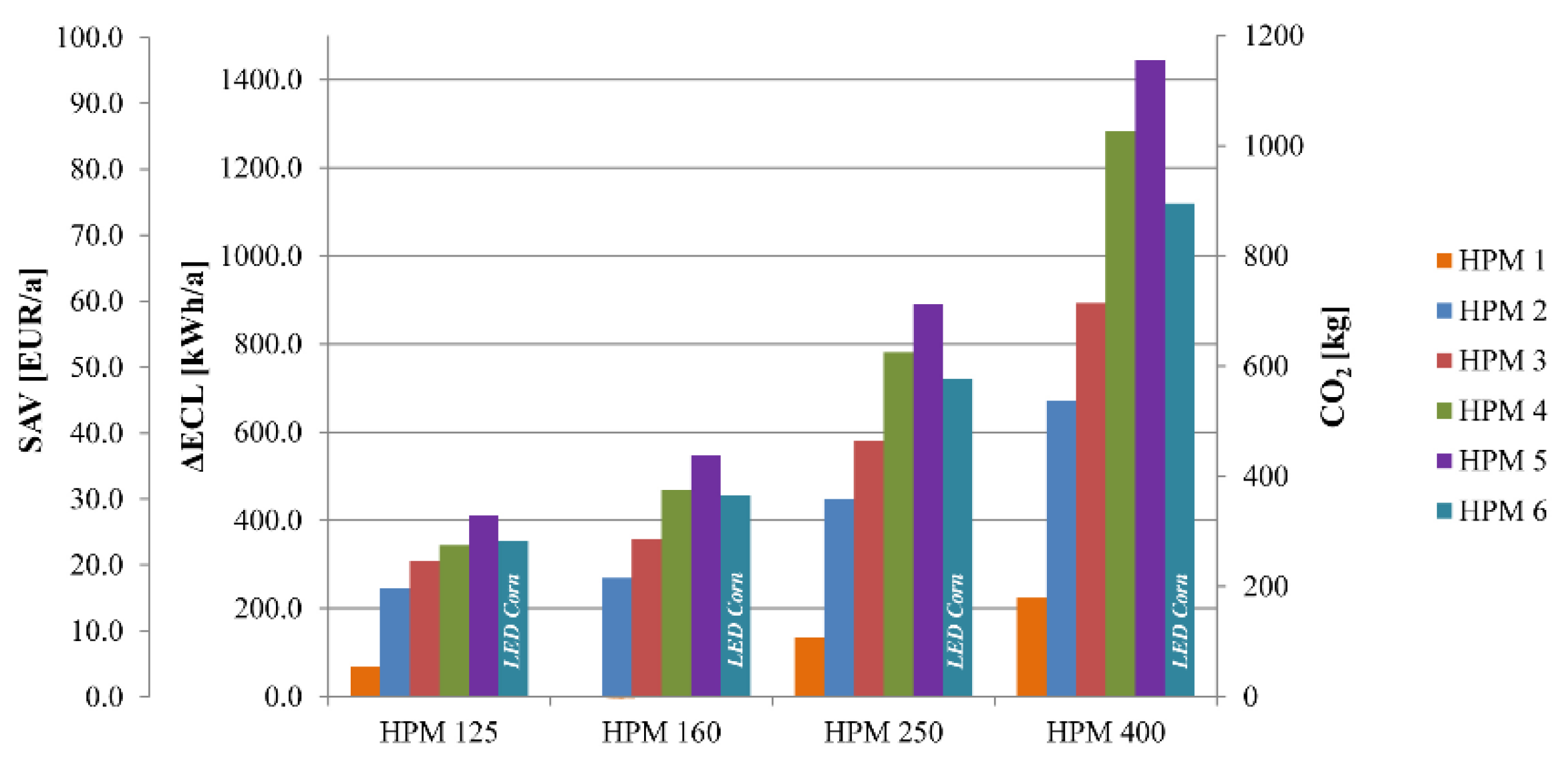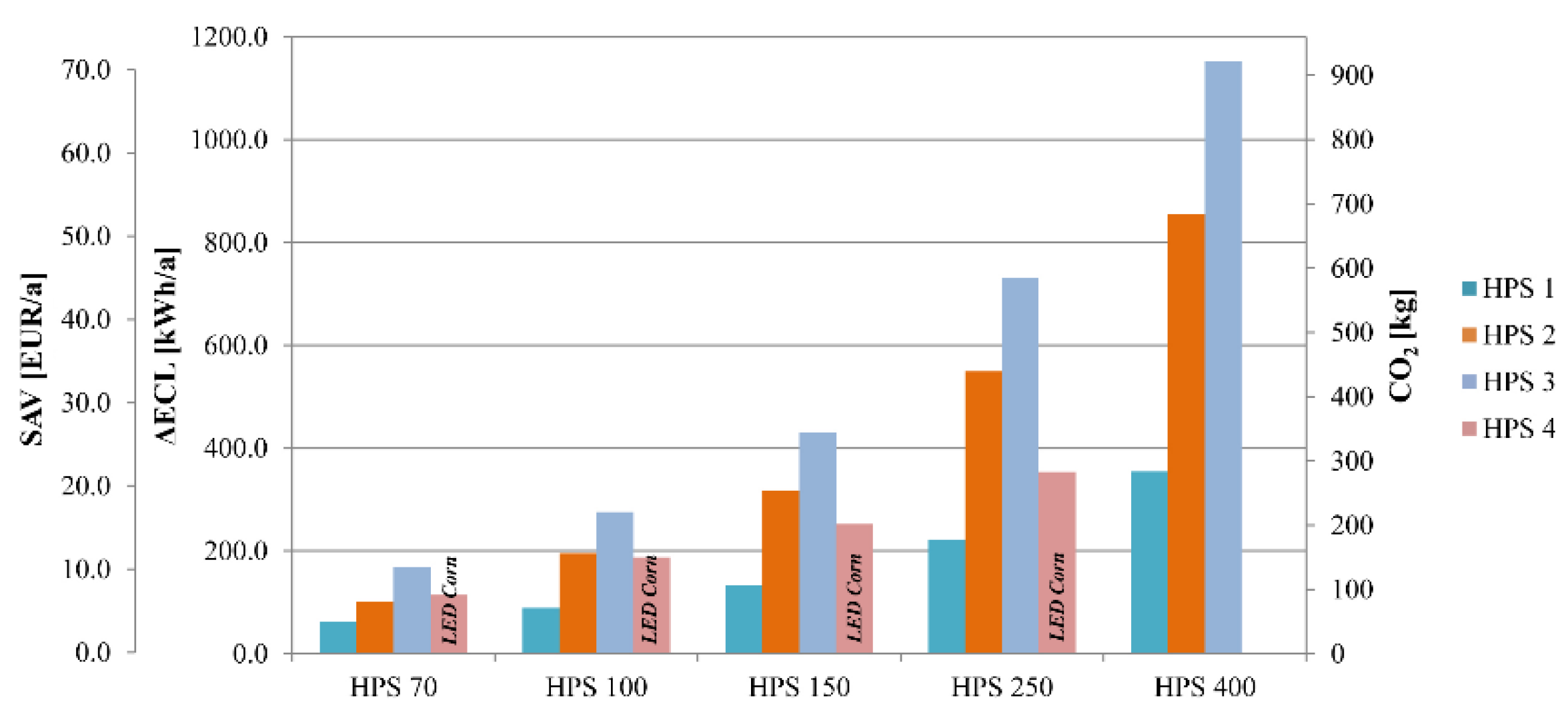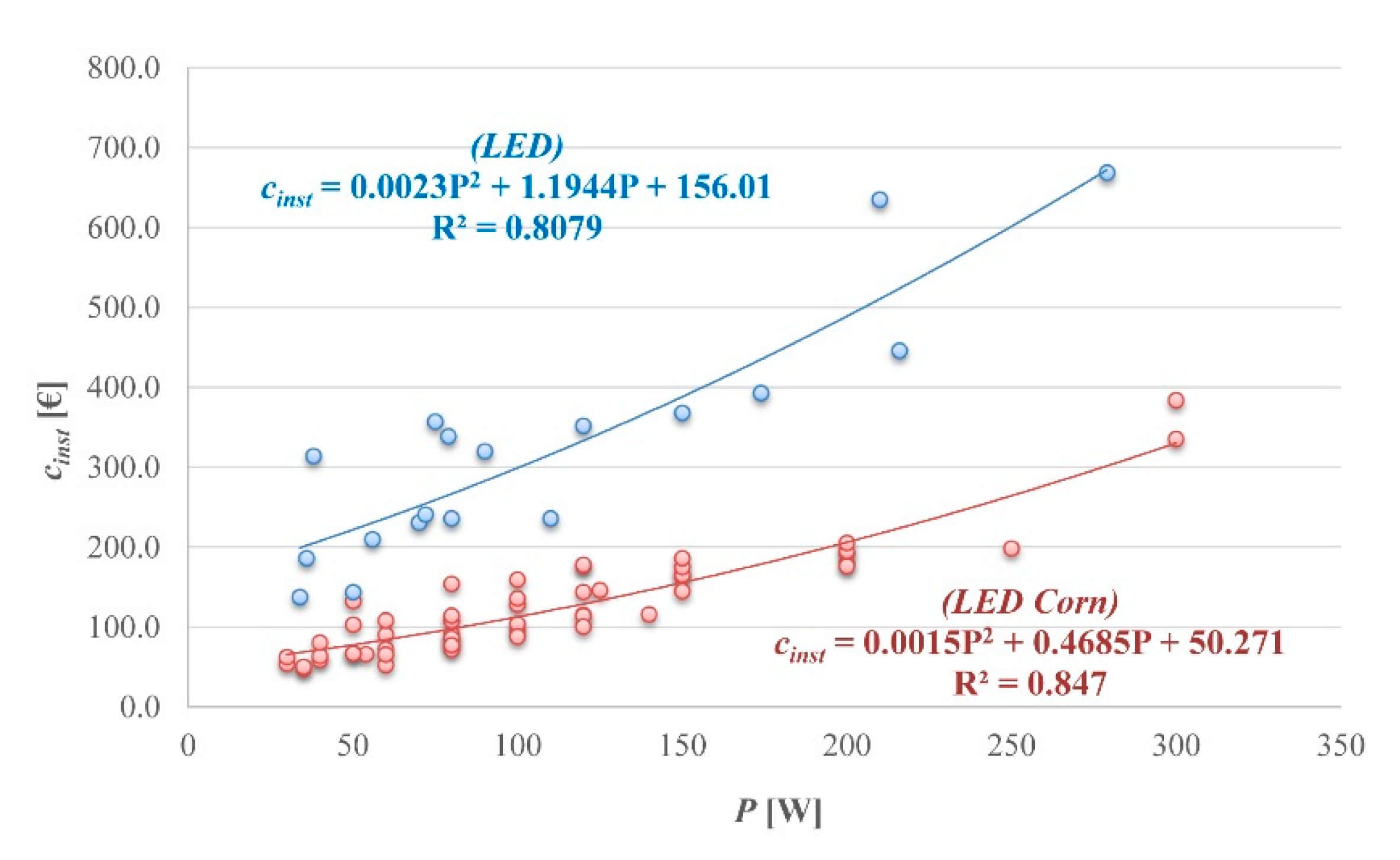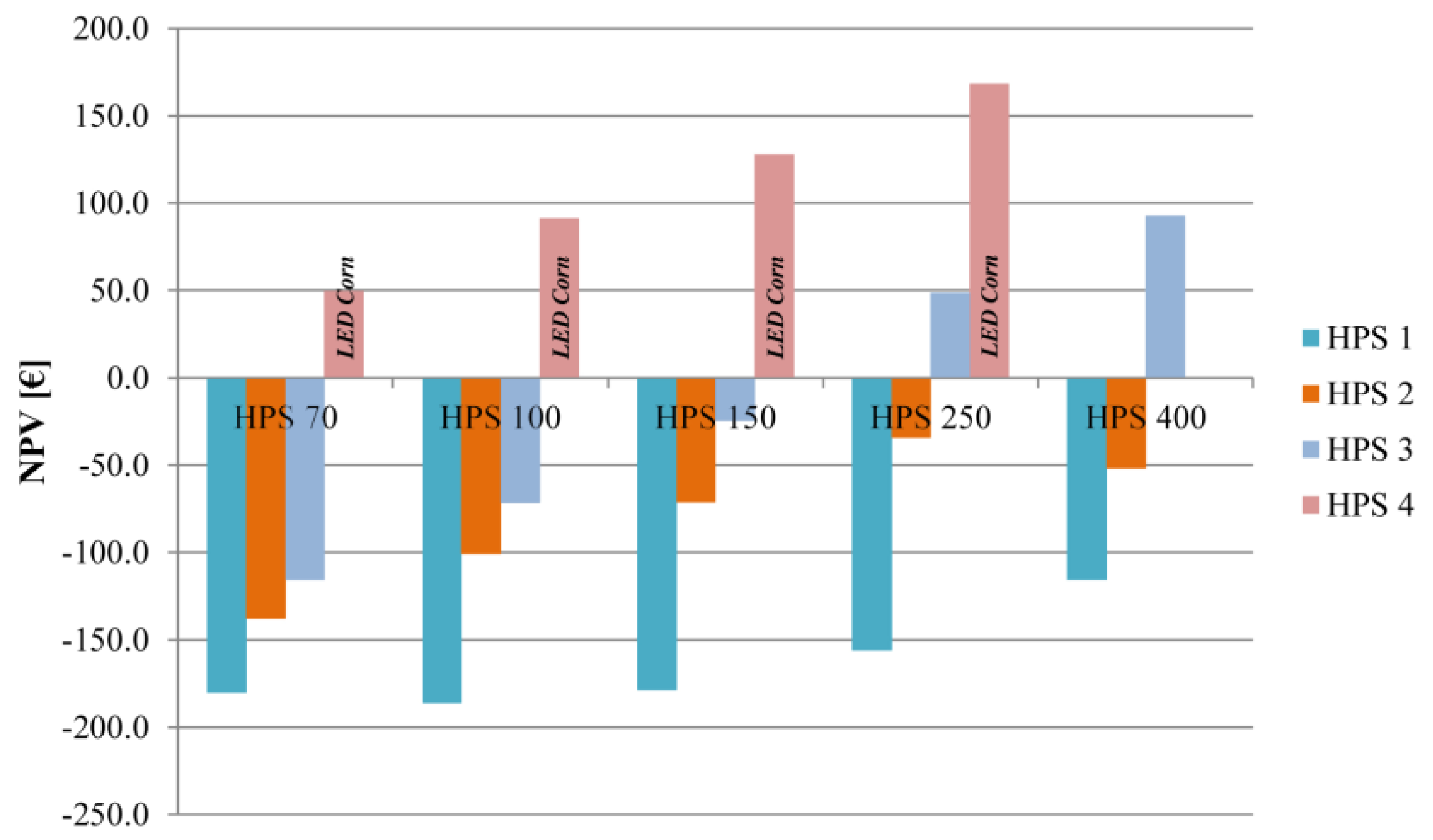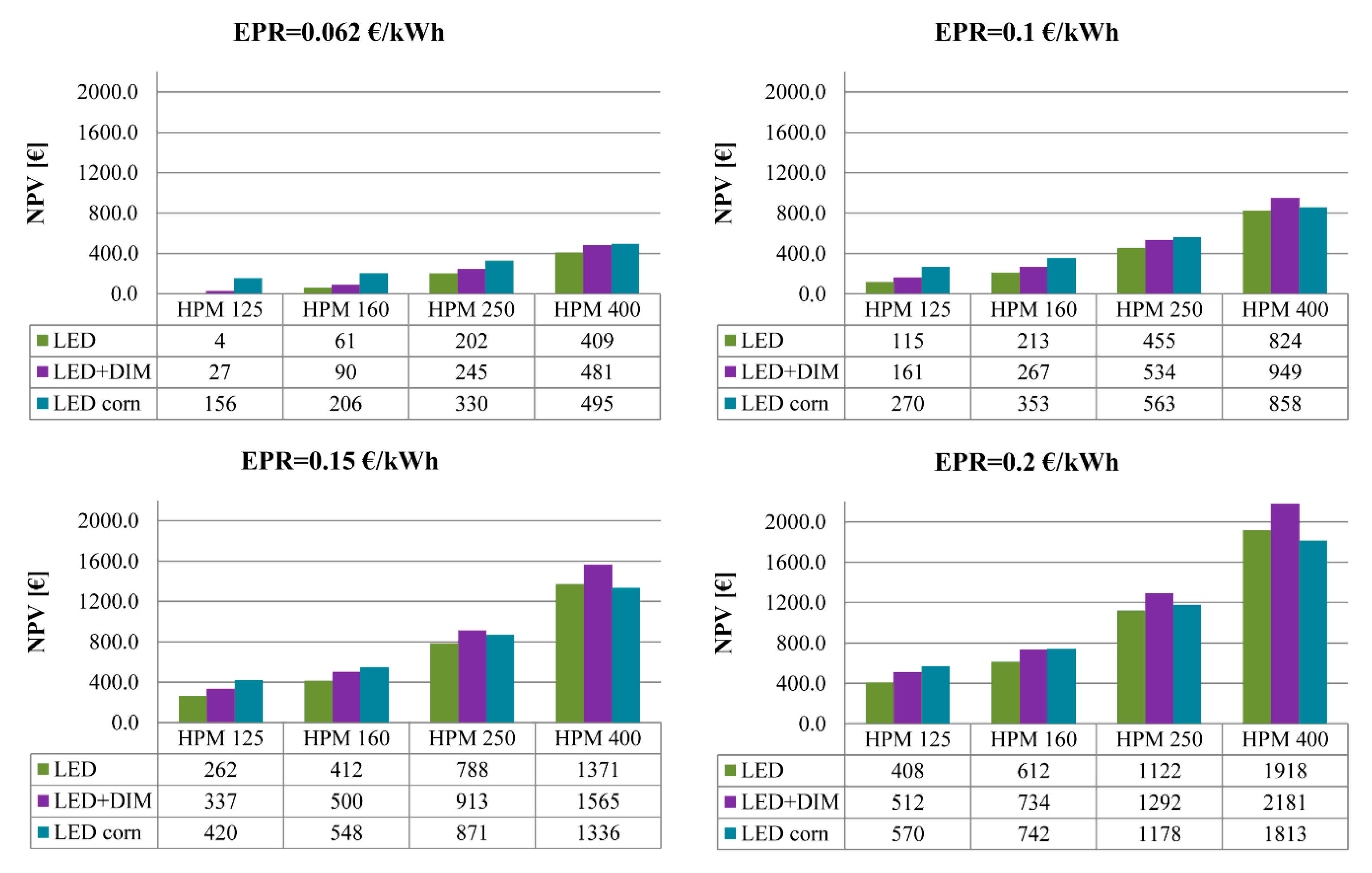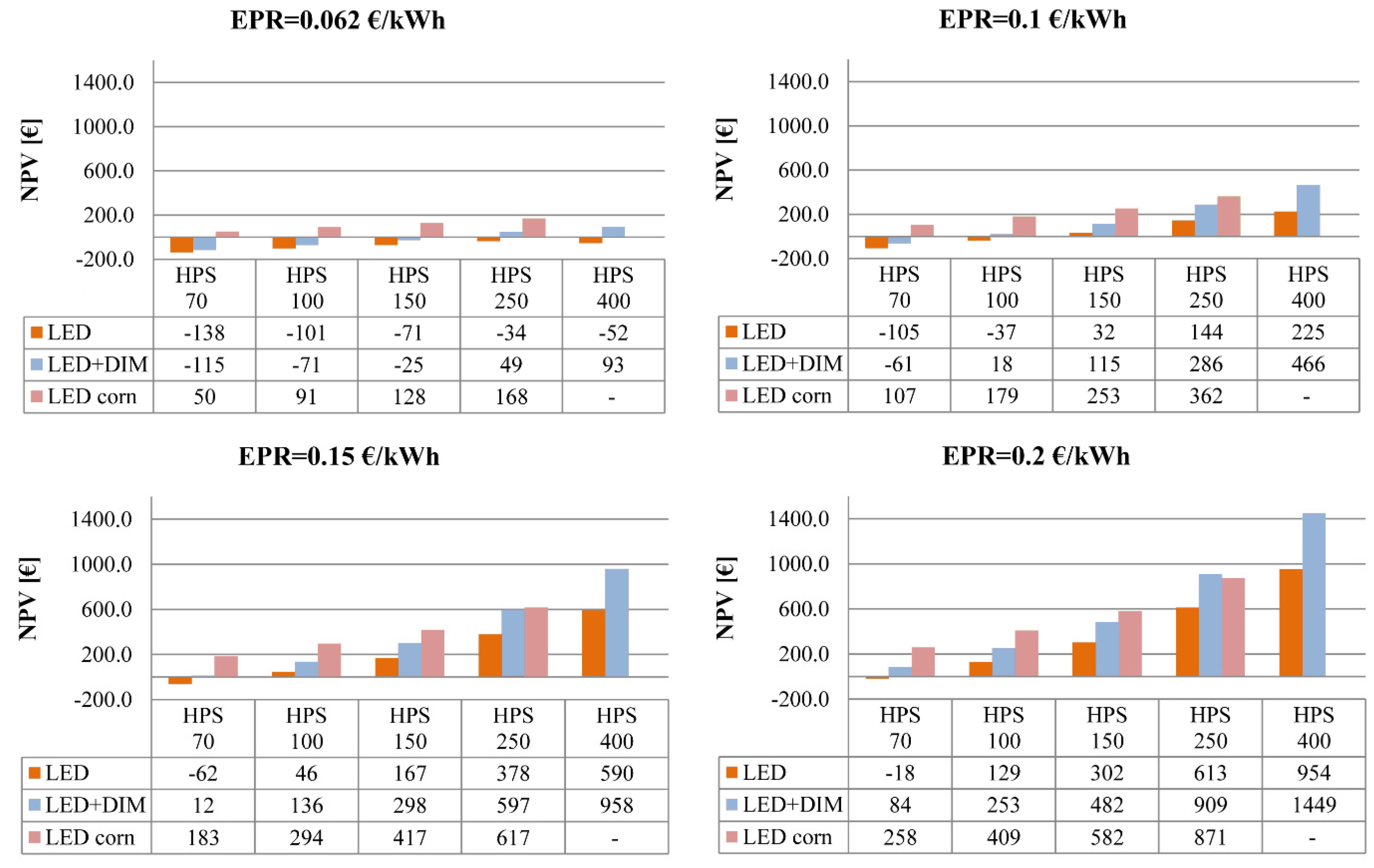1. Introduction
Public lighting is one of the basic needs of modern society, because it illuminates people and objects during the night when the level of natural light is inadequate. Appropriate public lighting brings a feeling of safety and comfort for users of public areas such as parks, streets, parking lots, promenades, etc. [
1,
2]. On the other hand, public lighting systems can lead to a high consumption of electricity, related to the use of inefficient equipment and poor management [
3]. Electricity consumption in public lighting systems represents a significant part of the energy balances of municipalities and cities around the world [
4,
5]. The electricity consumption of public lighting depends on the environment, citizens’ behaviour, and level of economic development of a society. According to the available data, public lighting contributes to around 2.3–4% of global energy consumption, of which the largest proportion is consumed by street lighting [
6]
Under the current global economic and energy efficiency trends, it is estimated that the energy consumption of public lighting will increase by 3.6% annually [
7]. Additionally, some studies have shown that the share of public lighting electricity consumption is about 12% of total electricity consumption of the public sector in Italy [
8,
9], about 3% of total energy consumption in Croatia and 1.1% in Serbia [
10]. Public lighting accounts for around 3.5 to 4% of total electricity consumption in the cities and municipalities of South America [
11]. In Israeli cities, about 47% of electricity consumption is the result of outdoor lighting systems [
12]. Costs related to the electricity consumption of public lighting systems may amount to 60% of total energy costs in municipalities in moderately warm climate regions [
13,
14].
Therefore, reducing the energy consumption of public lighting is a very important task. Local governments have an important role in the implementation of energy efficiency programs/projects and climate policies because they are active in the energy market both as consumers and as suppliers [
15]. Programs/projects for improving energy efficiency in public lighting systems are very important and very welcome, because savings can be greater than 30%, and in some cases, even up to 60–70% [
16,
17]. Worldwide, local governments have implemented energy efficiency programs/projects related to street lighting [
18]. The economic parameters of these projects depend on the existing system and planned energy saving measures [
6,
19].
However, local governments generally have limited budgets and therefore face many obstacles in managing and implementing these programs (projects), especially in less economically developed societies [
20,
21]. These obstacles are usually related to large investment costs and complicated organizational issues [
13,
22].
Several papers have focused on programs/projects for improving the energy efficiency of public lighting and related issues. Beccali et al. proposed a methodology for the evaluation of energy efficiency measures in street lighting which consisted of eight steps. The case study investigated the influence of the implementation of energy efficiency measures on the energy and economic parameters of a typical city [
8]. The high level of energy consumption can be caused by wrongly chosen streetlight equipment and over-lit areas [
23]. To reduce wasted energy caused by over-illuminated areas, the authors developed an empirical approach based on real-time technologies and GIS (geographic information systems).
Polzin et al. [
22,
24] proposed energy performance contracts as a solution to overcome barriers and uncertainness (existing partnerships, missing financial resources, low personnel capacity and overall financial constraints) for retrofitting existing lighting infrastructure. They analysed issues related to implementing LED street lighting in Germany. Radulovic, Skok, and Kirincic analysed the energy efficiency management of public lighting and concluded that management represents a driving force for the success of the projects [
25]. Salvia et al. have investigated the main energy efficiency practices used worldwide related to urban public lighting [
3]. To utilize solar energy for environmentally friendly streetlights, Sutopo et al. considered the implementation of solar-energy-based street lighting in Indonesia. Indonesia has a huge solar energy potential, and the authors showed that part of this potential could be utilized in street lighting [
26].
At the beginning of the 21st century, public lighting systems in the EU were predominantly based on the HPS (48.5%) and HPM (32.8%). Additionally, the public lighting systems have contained low-pressure sodium lamps (LPS) with a share of 8.6%, fluorescent (FL) around 7.7% and metal halide (MH) with a share of 2.5% [
2,
27]. Regulation (EC) No 245/2009 Fluorescent and high-intensity discharge lamp ecodesign requirements predicted that the share of energy-inefficient luminaires should be significantly reduced. The higher energy efficiency and environmental requirements resulted in an HPM ban from the EU market in April 2015 [
28]. The share of energy-inefficient lamps was reduced as a consequence. In 2015, the share of HPM was around 23.4%, and the share of more efficient HPS had increased to 53.5%. In the same period, the share of LED lamps was around 3.8% [
27].
The majority of implemented energy efficiency projects have considered replacing luminaires and sometimes the installation of a controlling system. Until recently, high-pressure sodium (HPS) luminaires were often installed as an alternative to high-pressure mercury (HPM) luminaires. Nowadays, light-emitting diode (LED) luminaires are installed as alternatives to both HPM and HPS as a more efficient solution, which offers great possibilities for the implementation of smart systems. Comodi, Cioccolanti, and Polonara considered the replacement of HPM lamps with LED lamps under short-term energy projects [
18], although several analyses have shown that the payback period for the installation of LED luminaires can be longer than 15 years [
29]. Therefore, the prediction is that LEDs will be used together with existing public lighting sources in the near future (before a complete conversion to LED systems) [
30].
An LED corn bulb is an assembly of light-emitting diodes on a metal heat-dissipation structure and represents a quick and easy solution for increasing the energy efficiency of existing street lighting. The LED corn offers an omni-directional lighting pattern unlike most of the current LED bulbs on the market, allowing for a true 360-degree luminescence. Technological developments of LED corn bulbs during the last few years have increased both the number of manufacturers and the quality of the product. According to the manufacturers’ specifications, they meet or exceed the quality of the light obtained from an HID-based bulb. On the other hand, according to the manufacturers, LED corn applications require a significantly lower investment compared to the installation of LED street luminaires.
Although LED corns have existed for several years on the market, as an HID bulb replacement for a variety of outdoor applications, there has been no analysis in the scientific literature related to their application for street lighting. Therefore, the authors analysed the techno-economic effects of replacing energy-inefficient street lighting with LED corn bulbs. The results were compared with other scenarios of increasing the energy efficiency of street lighting systems related to replacing luminaires, replacing inefficient lamps, and installing dimming control systems. The presented study fills a knowledge gap related to the usage of LED corn bulbs in street lighting systems, which is the biggest contribution to the scientific community of the paper.
This paper is organized as follows. The adopted and applied methodology is described in detail in
Section 2. Additionally, in this section data on different types of street lighting luminaires and bulbs are analysed. The results obtained by applying the defined methodology to the case study are presented and analysed in the third section. In the last section, the appropriate conclusions, recommendations, limitations, and directions for future research are presented.
2. Materials and Methods
The methodology for estimating the techno-economic effects of the implementation of energy efficiency measures (LED corn vs. alternatives) in a street lighting system includes the steps presented in
Figure 1.
2.1. Review of Existing Street Lighting Luminaires and Lamps
To review existing street lighting luminaires and lamps, we collected data of power and luminous fluxes of existing streetlight sources. The biggest numbers of inefficient street lighting sources in Europe are HPM and HPS lamps. Therefore, only improvements of street lighting based on those lamps are analysed in the paper. Basic properties of commonly used HPM and HPS street lighting sources are presented in
Table 1. Data are related to the most frequently used HPM and HPS lamps in Serbia. There is no significant difference between their luminous flux and the luminous flux of other lamps of the same type that can be found on the global market.
The implementation of Regulation (EC) No 245/2009 and existing obstacles for implementing energy efficiency projects on a local level have caused manufacturers to offer 110 W, 220 W and 350 W HPS lamps (with control gear designed for HPM lamps) that can be directly used in existing HPM luminaires as a more efficient alternative.
In terms of power, there are a variety of street lighting LED luminaires on the market. Based on collected data on LED street lighting sources available on the European market [
31,
32,
33,
34,
35,
36], the functional dependence of luminous flux and the power of a lamp is presented in
Figure 1. LED street lighting luminaires have better optical characteristics, i.e., they require less luminous flux to achieve the same light emission on the road surface. According to Djuretic and Kostic [
19,
37], around 50% of lighting flux of HPM and HPS luminaires falls on the road surface. In the case of LED luminaires, the percentage is around 70%. Taking this into account and using data from
Figure 2, the power of LED lamp
PLED [W] can be calculated as the function of luminous flux
Φv [lm] using the following second-degree polynomial:
Although LED corn bulbs are relatively new on the market, a significant number of different manufacturers exist. Only those lamps with adequate ingress protection for outdoor use and a minimal lifespan of 35,000 h were considered for the analysis. Systematizing the collected data on LED corn bulbs, the functional dependence of luminous flux and the power of available models of LED corn bulbs is shown in
Figure 1 [
38,
39,
40,
41,
42,
43,
44,
45]. According to the fact that the LED corn offers an omni-directional lighting pattern, it is also taken into account that around 50% of lighting flux falls on the road surface. According to
Figure 1, the power of an LED corn bulb
Pcorn [W] as the function of
Φv can be determined by Equation (2):
2.2. Scenarios for Energy Efficiency Improvement
There are four general scenarios for analysing energy efficiency improvements of an existing street lighting system with HPM and HPS lamps:
Dimming control of an existing system;
Installation of a new luminaire with a new lamp type;
Installation of a new luminaire with a new lamp type (including dimming control);
Lamp type replacement.
Installation of a new luminaire or lamp type replacement envisages the use of compatible solutions which enable maintaining the existing photometric parameters [
46].
The dimming control strategy reduces energy demand and optimizes lighting levels on the street according to the real requirements. Decreasing the voltage applied to the lamp, its lighting output is reduced. The voltage is controlled with a switchboard and energy savings are proportional to electrical power decreases and lamp operating hours.
Increasing the energy efficiency of an existing street lighting system is usually related to luminaire replacement. HPM lighting sources are replaced with HPS or LED alternatives, and HPS lighting sources are replaced with LED alternatives. HPM to HPS luminaire replacement can be performed using standardized HPS luminaires. The principle of HPM to HPS luminaire replacement is shown in
Table 2 [
10]. HPM or HPS to LED luminaire replacement should be performed in a way that the level of lighting flux of the existing system remains preserved upon the replacement.
The third scenario is related to the second scenario which includes dimming control.
The scenario of lamp type replacement is related to replacing existing HPM lamps with HPS or LED corn alternatives and replacing existing HPS lamps with LED corn alternatives. Thus, 110 W, 220 W and 350 W HPS lamps with opalized outer bulb are used as direct replacements for 125 W, 250 W and 400 W HPM lamps, respectively, because they operate on the same control gear. An adequate HPS retrofit for HPM 160 W does not exist because the share of this type of HPM is very small in public lighting systems. The replacement of an existing HPM or HPS lamp with an LED corn equivalent should be performed in a way that luminous flux of the existing system remains preserved and taking into account the reduction in illuminance due to lamp ageing [
47].
The following six energy efficiency improvement scenarios for HPM lamps can be considered according to the proposed general scenarios:
HPM1—Replacing HPM with HPS lamps (direct replacement);
HPM2—Replacing HPM with HPS luminaires;
HPM3—Replacing HPM with HPS luminaires with the additional dimming control;
HPM4—Replacing HPM with LED luminaires;
HPM5—Replacing HPM with LED luminaires with the additional dimming control;
HPM6—Replacing HPM lamps with LED corn bulbs.
HPM lamps are generally inefficient; therefore, their dimming control is not envisaged. According to defined principles of replacement and using Equations (1) and (2), the equivalent power of a lighting source for the HPM lamp/luminaire replacement is shown in
Table 2.
Similarly, the following four energy efficiency improvement scenarios for HPS lamps can be considered:
HPS1—Installing the dimming control system in the existing system;
HPS2—Replacing HPS with LED luminaires;
HPS3—Replacing HPS with LED luminaires with the additional dimming control;
HPS4—Replacing HPS lamps with LED corn bulbs.
The majority of LED corn bulbs available on the market are not dimmable; therefore, the scenario of installing dimmable LED corn bulbs is not envisaged. According to defined principles of replacement and using Equations (1) and (2), the equivalent power of a lighting source for HPS lamp/luminaire replacement is shown in
Table 3. It should be noted that the calculated power of an LED corn bulb is bigger than the value recommended by manufacturers.
2.3. Techno-Economic Analysis
Annual energy savings, annual financial savings, reductions in annual carbon dioxide (CO2) emissions, payback periods and net present values were calculated for each of the defined scenarios. In the following equations, subscript n is related to the new lighting source type and subscript e is related to the existing lighting source type.
Annual energy saving ∆
ECL [Wh/year] can be calculated according to:
ECL [Wh/year] is the annual electricity consumption of a light source, and fdim [%] is the dimming factor (the ratio between the estimated equivalent annual number of working hours after included dimming control and the current estimated annual working hours of public lighting).
Annual electricity consumption of a light source can be calculated according to:
P [W] denotes the power of a light source, ΔP [W] is the power demand of light source ballast (equal to 0.1∙P for HPM and HPS, and 0 for LED and LED corn bulbs) and τ [h] is the estimated annual working hours of public lighting.
Total CO
2 emissions reductions, ΔCO
2em [t/year], can be calculated as the product of annual energy saving and annual CO
2 emission factor for electricity generation
fCO2 [t/kWh]:
Energy saving leads to financial savings,
SAV [EUR/year], which can be calculated by:
EPR [EUR/kWh] is the price of electricity, and MCL [EUR/year] is the annual maintenance cost.
Annual maintenance costs can be calculated using the following mathematical expression:
Nrep [-/year] is the number of annual lamp replacements, cbulb [EUR] is the cost of a single lamp, and crep [EUR] denotes the replacement cost of a single lamp.
The number of annual lamp replacements can be calculated as:
lt [h] is the lamp lifetime, presented in
Table 4.
Energy efficiency improvement costs,
COST [EUR], are:
where
cinst [EUR] is a new lamp and/or luminaire installation cost, and
cdim [EUR] is the dimming control system installation cost.
Payback period
PB [year] of implemented energy efficiency measures can be calculated according to:
For each of the scenarios, net present value
NPV [EUR] of the implemented energy efficiency measure can be calculated as:
d [%] is the real discount rate, and elt [year] is an economic lifetime of the measure.
3. Results and Discussion
The estimated annual working hours of a public lighting system are influenced by the length of the night during the year, which depends on a specific location. The city of Kragujevac (Serbia) (44°0′51″ N, 20°54′42″ E) was taken for further analysis. According to the street lighting working schedule, the estimated number of annual working hours of public lighting in Kragujevac is
τ = 4070 h. The annual electricity consumption of each of the existing HPM and HPS lamps is presented in
Table 5.
Different dimming strategies can be found in practice. In this paper, three levels of dimming control were envisaged: 100%, 75%, and 50%. The proposed principle of dimming control (
Table 6) was obtained based on recommendations [
8,
19,
48] and analysis of the activities of the citizens of Kragujevac. The design luminous flux (100%) was kept during the first operating hours after turning on the street lighting. In early night hours, a second step control was applied with a light flux of 75%. Finally, the biggest savings were obtained during the third step of the control with a light flux of 50% (
Table 6).
According to the proposed dimming control strategy, the estimated equivalent annual number of working hours after including the dimming control of HPS lamps was 3264 h (dimming factor fdim = 0.8). For LED lamps, τ = 2776 h (fdim = 0.68).
Replacing the luminaires or lamps and the installation of the dimming control system will result in increased energy efficiency. Annual energy savings, financial savings and CO
2 emissions which could be achieved by applying the proposed energy efficiency improvement scenarios to HPM, i.e., HPS lighting sources, are shown in
Figure 3 and
Figure 4, respectively. For the calculations, the price of electricity in public lighting systems in Serbia
EPR = 0.062 EUR/kWh (fixed value) and the annual CO
2 emission factors for the generation of electricity for Serbian grid
fCO2 = 0.8 kg/kWh were taken into account.
fCO2 in Europe is in a range from 37 gCO
2/kWh in Sweden to 957 gCO
2/kWh in Estonia [
49].
LED luminaires with dimming control provide the greatest savings, followed by LED luminaires without dimming control and LED corn bulbs (where their adequate replacement exists).
The average prices of HPM and HPS street lighting lamps that can be found on the local market are presented in
Table 7.
Dependence of both the LED corn bulb price and the LED luminaire price on power were obtained based on the collected data on available models and their prices,
Figure 5 [
31,
32,
33,
34,
35,
36,
38,
39,
40,
41,
42,
43,
44,
45].
The cost of a single lamp replacement can be considered the same for all types, crep = EUR 8, except for LED corn bulb, crep = EUR 12 because it includes ballast bypassing.
A large number of HPS luminaires can be found on the market. Depending on the degree of protection (IP), optical properties, materials from which they are made, design style, etc., the prices are in a very wide range. For this reason, the average low-cost and the average high-cost values were considered (
Table 8).
A dimming control system consists of different components depending on the lamp type. In addition to a central controller, which enables controlling up to 120 lamps, for HPS luminaires, it includes the controller assembly and dimmable ballast. Most contemporary LED luminaires have built-in controllers with the possibility of different dimming levels. Taking everything into account, the average prices of a dimming control system,
cdim [EUR], for different HPS and LED light sources are presented in
Table 9.
The calculations of the payback period for different energy efficiency improvement scenarios are presented in
Figure 5 and
Figure 6. The payback period generally decreases with the increase in the power of a lamp for each of the scenarios.
The installation of a dimming control system significantly increases the price of new HPS luminaires, and the payback period has the highest value for these systems (from about 14–18 years for small-power luminaires up to about 7–9 years for higher-power luminaires) (
Figure 6). Direct replacement of HPM lamps with HPS lamps provides a very short payback period, but energy savings and reductions in CO
2 emissions are significantly smaller comparing to the alternatives. Although the price of electricity in Serbia is low, the installation of new LED luminaires provides a shorter payback period than the installation of HPS luminaires (except in the case of cheaper HPS luminaires). The installation of dimming controls of LED luminaires has a positive effect because it provides a shorter payback period. The installation of LED corn bulbs provides the shortest payback period ranging from 2.15 years (for HPM 400 W replacement) up to 2.83 years (for HPM 125 W replacement). The difference in payback period between the installation of LED luminaires and LED corn bulbs reduces for higher-power HPM lamps.
The financial analysis showed that the dimming control of existing HPS lamps is financially unattractive because the payback periods are extremely high (more than 13 years) (
Figure 7). The installation of LED luminaires also provides a long payback period. For smaller-power lamps, the payback period even exceeds the declared lifespan of an LED luminaire. As in the case of improving the energy efficiency of HPM lighting sources, LED corn bulbs are the most favourable solution where adequate replacements exist.
The payback period is a static economic indicator that has certain limitations:
It provides adequate results only when the real interest rate is low;
It is desirable to for use when selecting the projects for which PB is shorter than 4–5 years;
It does not take into account the value of annual savings after the payback period.
Therefore, the net present value, as a dynamic indicator, should be also used. The
NPV for each of the proposed energy efficiency improvement scenarios is shown in
Figure 8 and
Figure 9. For the calculations of
NPV, the value of
elt = 10 years was considered.
There are several economically justified alternatives for improving the energy efficiency of existing HPM lamps (those where
NPV > 0) (
Figure 8). LED corn installation is the most attractive measure, especially for HPM 125 W and HPM 160 W where no competitive alternatives exist. For HPM 250 W and, especially, HPM 400 W, the installation of new LED luminaires (particularly those with dimming control) is a competitive solution. The installation of LED corn bulbs is the only economically justified solution for improving the energy efficiency of existing 70 W, 100 W and 150 W HPS lamps (
Figure 9). The installation of LED luminaires with dimming control is one economically justified alternative for HPS 250 W, whereas it is the only economically justified solution for HPS 400 W.
According to EUROSTAT (2019), the price of non-household electricity in Serbia is among the lowest in Europe. Therefore, the authors performed the sensitivity analysis for the cases of higher prices of electricity (0.1 EUR/kWh, 0.15 EUR/kWh and 0.2 EUR/kWh). Only the scenarios of installing LED luminaires with or without dimming control and LED corn bulbs were analysed. The results of the analysis are presented in
Figure 10 and
Figure 11.
In the case of increasing the energy efficiency of HPM 250 W and 400 W lamps, installation of LED luminaires with dimming controls became the most financially attractive alternative for a higher price of electricity. LED corn remains the most favourable solution for smaller-power lamps (HPM 125 W and HPM 160 W). In the case of increasing energy efficiency of existing HPS lamps, installation of LED corn is an economically preferable solution except for HPS 250 W and the high price of electricity (0.2 EUR/kWh).
4. Conclusions
In recent years, LED lighting technology has become sufficiently developed and financially viable to be used in public lighting systems. Installations of LED luminaires are usually recommended because they provide energy-efficient application (high luminous efficacy and possibilities for the smart street lighting system). The present research shows that dimming control of LED luminaries provides better financial effects than the installation of LED luminaires without dimming controls.
However, the installation of new LED luminaires still requires a significant investment that often presents a limiting factor for local governments. The installation of LED corn bulbs is an adequate solution in the widest light source power range. Luminaires with low-power lamps (i.e., HPM 125 W, HMP 160 W, HPS 70 W, HPS 100 W and HPS 150 W) are very common in existing public lighting systems. Replacement of these lamps with LED corn bulbs is the most economically favourable solution which provides desirable economic project parameters with relatively low investments. Moreover, in the case of low electricity price, it presents the only economically justified solution for some luminaires. It should be emphasized that the main prerequisite for the installation of LED corn bulbs is the satisfactory condition of existing luminaires. If an existing luminary is obsolete or poorly maintained, the lamp should not be replaced with LED corn bulb, i.e., the new efficient luminary must be installed.
The presented methodology offers the possibility to analyse the effects of the implementation of energy efficiency measures in the public lighting system. The model enables local government decision-makers to perform feasibility studies to determine favourable solutions. To determine favourable solutions for improving energy efficiency at a particular location (city/municipality/other administrative units), detailed data on location, attributes and the condition of streetlights are required. The methodology is universal, and it can be applied to any location whilst taking into account data of local equipment price and associated costs. An improvement of the methodology would be the inclusion of multi-criteria decision-making analysis (MCDM), which will be a future direction of the authors’ research. In addition to economic criteria, the MCDM should include environmental and social criteria. This should enable the selection of sustainable solutions for increasing the energy efficiency of a street lighting system. Experimental verification of photometric parameters of LED corn bulbs in street lighting should be the subject of our future research.
